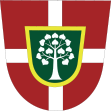Žlutava
| Žlutava | ||||
|---|---|---|---|---|
|
||||
| Basic data | ||||
| State : |
|
|||
| Region : | Zlínský kraj | |||
| District : | Zlín | |||
| Area : | 740 ha | |||
| Geographic location : | 49 ° 12 ' N , 17 ° 29' E | |||
| Height: | 298 m nm | |||
| Residents : | 1,182 (Jan 1, 2019) | |||
| Postal code : | 763 61 | |||
| License plate : | Z | |||
| traffic | ||||
| Street: | Kvasice - Napajedla | |||
| structure | ||||
| Status: | local community | |||
| Districts: | 1 | |||
| administration | ||||
| Mayor : | Stanislav Kolář (as of 2010) | |||
| Address: | Žlutava 271 763 61 Napajedla |
|||
| Municipality number: | 586013 | |||
| Website : | www.zlutava.cz | |||
Žlutava (German Schlutawa , formerly Zuttaw ) is a municipality in the Czech Republic . It is four kilometers west of Otrokovice and belongs to the Okres Zlín .
geography
Žlutava is located on the right side above the valley of the March in the north-eastern foothills of the Mars Mountains on the edge of the Chřiby nature park. The Dřevnice flows into the March to the east of the village . To the north rises the Tresný (278 m), in the east the Dubová (307 m) and west the Sudná (344 m). To the southwest is the Žlutava sandstone quarry.
Neighboring towns are Roma Nice and Bělov in the north, Bahňák in the Northeast, Otrokovice and Kvítkovice the east, Pod Dubovou, Oldřichovice , Pohořelice and Napajedla in the southeast, Žlaby, Šardice, Zadřínové, Kateřinice and Halenkovice in the south, Kržle in the southwest, Kozinec and Kostelany in the West and Nová Dědina , Podkoryta and Kopaniny in the north-west.
history
Archaeological finds prove an early settlement of the area. These include several storage areas for mammoth hunters from the Paleolithic , as well as other finds from the Neolithic , Bronze Age and the time of the Great Moravian Empire .
Žlutava was founded in the second half of the 17th century by Johann von Rottal . The first written mention of the village belonging to the Napajedla rule was made in 1671 under the name Zutowa . Zutowa always remained submissive to Napajedla until the middle of the 19th century .
After the abolition of patrimonial Zutowa / Zuttaw formed from 1850 a municipality in the district administration Uherské Hradiště . In 1863 the whole village burned down. In 1866, Prussian troops brought in cholera , from which 76 residents died within two weeks. From 1872 the municipality was called Žlutavá , from 1881 as Žlutavy and from 1885 as Žutavy . The road from Napajedla via Žutavy to the stately sandstone quarry was built in 1885. In 1892 the elementary school was built. The current place name Žlutava has been in use since 1893. On the village green was the so-called laundry, a 4 × 3 m large and one and a half meter deep pit. It was used by the women of the village to wash laundry and diapers and to clean agricultural utensils from dung. Because of the contamination of the drinking water well next to it from the laundry, the dysentery broke out. As a result of the epidemic in which twelve people died, the laundry was filled in in 1902. In 1902 the volunteer fire brigade was founded. The following year the road to Bělov was built . In 1930 there were 880 people living in the parish. After the Baťa works in Otrokovice were established , some of the residents found employment there. In 1954 the population had grown to 1,040. Ten years later the village had 1,106 inhabitants. From 1950 the community belonged to the Okres Gottwaldov-okolí and from 1961 to the Okres Gottwaldov, which has been called Okres Zlín again since 1990 . The sandstone quarry is now operated by Kamenolom Žlutava sro.
Community structure
No districts are designated for the municipality of Žlutava. The settlements Kozinec, Romanice and Žlaby belong to Žlutava.
Attractions
- Church of St. Kyrill und Method, built in 1939 on the village green instead of a bell tower
- Chapel on the Sudná in the upper village
- Two mighty linden trees, one growing in front of the primary school, the other next to the chapel
- Memorial to the fallen of the First World War on the Freiheitslinde, erected in 1929
- Memorial stone for TGMasaryk, it was erected in 1938 on the village green




